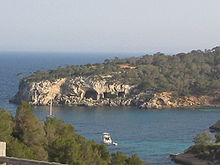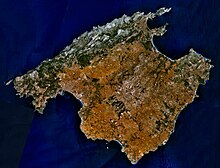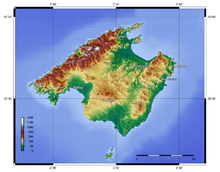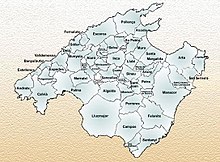Mallorca: Difference between revisions
m Reverted edits by 83.67.88.205 (talk) to last version by 70.252.92.119 |
→20th Century and Today: not exactly an important event in the history of Majorca |
||
| Line 73: | Line 73: | ||
The boom in tourism caused Palma to grow significantly, with repercussions on immigration. In 1960 Majorca received 500,000 visitors, while in 1997 it received 6,739,700. In 2008, 22,832,865 passengers passed through ''[[Son Sant Joan Airport]]'' in Palma, with an additional 1.5 million arriving by sea. |
The boom in tourism caused Palma to grow significantly, with repercussions on immigration. In 1960 Majorca received 500,000 visitors, while in 1997 it received 6,739,700. In 2008, 22,832,865 passengers passed through ''[[Son Sant Joan Airport]]'' in Palma, with an additional 1.5 million arriving by sea. |
||
In the 21st century, urban redevelopment, under the so-called ''Pla Mirall'' (English "Mirror Plan"), attracted important groups of immigrant workers from outside the [[European Union]], especially from [[Africa]] and [[South America]].<ref>[http://themallorca.net/2009/01/15/large-rise-in-number-of-foreign-nationals/ Large rise in number of foreign nationals]. The Mallorca. January 15, 2009.</ref> |
In the 21st century, urban redevelopment, under the so-called ''Pla Mirall'' (English "Mirror Plan"), attracted important groups of immigrant workers from outside the [[European Union]], especially from [[Africa]] and [[South America]].<ref>[http://themallorca.net/2009/01/15/large-rise-in-number-of-foreign-nationals/ Large rise in number of foreign nationals]. The Mallorca. January 15, 2009.</ref> |
||
On November 14, 2006, the local newspaper ''Diario de Mallorca'' reported allegations that the CIA used an airport on the island for its controversial [[Extraordinary rendition by the United States|extraordinary rendition]] program. |
|||
==Climate== |
==Climate== |
||
Revision as of 21:38, 30 July 2009
Nickname: majja | |
|---|---|
 | |
| Geography | |
| Location | Mediterranean Sea |
| Coordinates | 39°37′N 2°59′E / 39.617°N 2.983°E |
| Archipelago | Balearic Islands |
| Administration | |
Spain | |
| Demographics | |
| Population | 790,763 |
Majorca (Spanish and Catalan: Mallorca) is the largest island of Spain. It is located in the Mediterranean Sea and part of the Balearic Islands archipelago. The name derives from Latin insula maior, "larger island"; later Maiorica.
The capital of the island, Palma, is also the capital of the autonomous community of the Balearic Islands. The Cabrera archipelago is administratively grouped with Majorca (in the municipality of Palma). The anthem of Majorca is La Balanguera.
Like the other Balearic Islands of Ibiza, Formentera, and Minorca, the island is a popular tourist destination. In Germany, the United Kingdom and to a lesser extent, Ireland, where package tourism to the island started in May 1952, Majorca has remained a popular destination.
History
Founding of Majorca
Majorca has been inhabited since antiquity. Burial chambers and traces of habitation from the Paleolithic period (6000–4000 BC) have been discovered. The island was occupied by the Romans in 123 BC under Quintus Caecilius Metellus Balearicus. It flourished under Roman rule, during which time the towns of Pollentia (Alcúdia), and Palmaria (Palma) were founded. The local economy was largely driven by Olive cultivation, viniculture, and salt mining. Majorcan soldiers were valued within the Roman legions for their skill with the sling.
In 426, the Vandals sacked the island, and annexed it to their kingdom in 465. In 534, Majorca was conquered by the Byzantine Empire, and administered as part of the province of Sardinia. Under Byzantine rule, Christianity flourished and numerous churches were built. But from 707, the island was increasingly attacked by Muslim raiders from North Africa.

In 902, the Caliphate of Cordoba conquered Majorca, ushering in a new period of prosperity for the island. With the Caliphate at its height, the Moors improved agriculture with irrigation, developed local industries and the island benefited from the overall prosperous times. After the Caliphate was dismembered in 1015, a new, more decadent, era started. Majorca came under rule by the Taifa of Denia, and from 1087–1114 was an independent taifa. However, in 1114, an expedition of Pisans and Catalans overran the island, laying siege to Palma for 8 months. After the city fell, the invaders retreated, and were replaced by the Almoravides from North Africa, who ruled till 1203. The Almoravides were replaced by the Almohad dynasty until 1229. In the ensuing confusion and unrest, King James I of Aragon launched an invasion which landed on Santa Ponsa, Majorca, on September 8-9, 1229 with 15,000 men and 1,500 horses, entering the city of Madina Mayurqa on December 31, 1229, and annexing the island to his Crown of Aragon after a campaign which finalized on October 30, 1230.
After the death of James I in 1276, his kingdom was divided between his sons. James II became king of the new Kingdom of Majorca. In 1344, King Peter IV of Aragon invaded, and re-incorporated the island into the Crown.
From 1479, the Crown of Aragon was in dynastic union with that of Castile. The Barbary corsairs of North Africa often attacked the Balearic Islands, and in response many coastal watchtowers and fortified churches were erected. In 1570, King Philip II of Spain and his advisors were considering complete evacuation of the Balearic islands.[1] In the early 18th century, the War of the Spanish Succession resulted in the replacement of that dynastic union with a unified Spanish monarchy. In 1716 the Decretos de Nueva Planta made Majorca part of the Spanish province of Baleares, roughly equivalent to present-day Illes Balears province and autonomous community. In 1891 a disease destroyed Majorca’s vineyards and decimated the island's main source of income. From 1891 to 1895 Majorca witnessed a large emigration of islanders to mainland Spain and to the Americas.
Palma

The capital of Majorca, Palma, was founded as a Roman camp called Palmaria upon the remains of a Talaiotic settlement. The turbulent history of the city saw it subject to several Vandal sackings during the fall of the Roman Empire. It was later reconquered by the Byzantine, colonised by the Moors (who called it Medina Mayurqa), and finally established by James I of Aragon. In 1983, Palma became the capital of the autonomous region of the Balearic Islands.
20th Century and Today

A Nationalist stronghold at the start of the Spanish Civil War, Majorca was subjected to an amphibious landing, on August 16 1936, aimed at driving the Nationalists from Majorca and reclaiming the island for the Republic. Although the Republicans heavily outnumbered their opponents and managed to push 12 kilometres inland, superior Nationalist air power mainly provided by Fascist Italy forced the Republicans to retreat and to leave the island completely by September 12. Those events became known as the Battle of Mallorca.
For the rest of the Civil War the island was used as a base for the Nationalist navy and airforce, who mounted raids on the Spanish mainland.
Since the 1950s, the advent of mass tourism radically changed the physiognomy of both the city and the island, transforming it into a centre of attraction for foreign visitors and attracting workers from mainland Spain. This contributed to a huge change in the traditions, the sociolinguistic map, urbanisation and acquisitive power.
The boom in tourism caused Palma to grow significantly, with repercussions on immigration. In 1960 Majorca received 500,000 visitors, while in 1997 it received 6,739,700. In 2008, 22,832,865 passengers passed through Son Sant Joan Airport in Palma, with an additional 1.5 million arriving by sea.
In the 21st century, urban redevelopment, under the so-called Pla Mirall (English "Mirror Plan"), attracted important groups of immigrant workers from outside the European Union, especially from Africa and South America.[2]
Climate
The climate of Majorca is a Mediterranean Climate. With mild and stormy winters and hot, bright summers.
| Climate data for Majorca | |||||||||||||
|---|---|---|---|---|---|---|---|---|---|---|---|---|---|
| Month | Jan | Feb | Mar | Apr | May | Jun | Jul | Aug | Sep | Oct | Nov | Dec | Year |
| [citation needed] | |||||||||||||
Geography


Majorca has two mountainous regions each about 70 km in length. These occupy the north-western (Serra de Tramuntana or Tramuntana range) and eastern thirds of the island. The highest peak on Majorca is Puig Major (1,445 m) in the Serra de Tramuntana. As this is a military zone, the neighbouring peak at Puig de Massanella is considered the highest accessible peak (1,364 m). The northeast coast comprises two sweeping bays: the Badia de Pollença and the larger Badia d'Alcúdia. The northern coast is generally rugged and has many cliffs. The central zone extending from Palma is generally flat fertile plain known as Es Pla.
The climate is Mediterranean, with markedly higher precipitation in the Serra de Tramuntana. Summers are hot in the plains and winters mild to cool, getting colder in the Tramuntana range; in this part of the island brief episodes of snow during the winter are not unusual.
The island is surrounded by two uninhabited small islands: Cabrera (southeast of Palma) and Dragonera (west of Palma).
Administration

The island is administratively divided into these municipalities:
Attractions
People
Famous Majorcans include writer and philosopher Ramon Llull and Junípero Serra, the Franciscan friar who founded the mission chain in Alta California. From the 19th century, the military commander, Joaquin Jovellar y Soler, and two time Spanish Prime Minister, Antonio Maura Montaner. More recently, sportsmen from the island include basketball player Rudy Fernández, as well as former world no. 1 tennis player Rafael Nadal and former world no. 1 tennis player Carlos Moyà. Rafael Nadal's uncle is the former Spanish international footballer, Miguel Ángel Nadal. In 2006, Majorca's Jorge Lorenzo won the world 250cc motor cycling title. Former Everton F.C. footballer, Duncan Ferguson now resides in Majorca.
This island is also home to internationally known contemporary painters such as Miquel Barceló, José María Sicilia, and Astrid Colomar.
The members of the Spanish Royal Family traditionally spend their summer holidays [3] in Majorca where the Marivent Palace(image) is located [4]. The Marivent Palace( image & map ) is the royal family's summer residence. While most royal residences are administered by Patrimonio Nacional, the Marivent Palace, in Palma de Mallorca, one of many Spanish royal sites, is under the care of Government of the Balearic Islands. As a private residence it is rarely used for official business. Typically, the whole family meets there and the Fortuna yacht, where they take part in sailing competitions [5]. However unofficial business does occur (though rarely) at the Marivent Palace such as when Hugo Chavez, current (2009) President of Venezuela, visited King Juan Carlos at the Marivent Palace in 2008[6] to mend their relationship and normalize diplomatic relations after the King ( now famously [7]) told him, " Why don't you shut up? " during the Ibero-American summit in November of 2007[8].
Language
The official languages of Majorca are Catalan and Spanish. The local dialect of Catalan is Mallorquí, even though the dialects are different in each island and in most villages. Typically, young Majorcans are bilingual in Catalan and Spanish, with some knowledge of English or German as a foreign language, especially due to the large number of tourists and foreign residents on the island.
Economy
Since the 1950’s Majorca has become a well-known tourist destination, and the tourism business has become the main source of revenue for the island. In 2001, the island received millions of tourists and day by day, the boom in the tourism industry provided significant growth in the economy of Majorca. With more than half of the population working in the tourist sector, a vast amount, approximately 80%, is contributed to Majorca’s GDP.[9]
Politics

The Balearic Islands, of which Majorca forms part, is one of the Spanish autonomous communities. It is currently governed by a coalition of five different leftist and nationalist parties headed by the Partit Socialista (PSOE) under Francesc Antich.
There is a specific government for the island which is called Consell Insular de Mallorca (Majorca Insular Council) with competences in culture, roads, railways (see Serveis Ferroviaris de Mallorca) and municipal administration. As of 2008, the president of the institution is Francina Armengol from PSIB-PSOE.
Cuisine

In 2005, there were over 2,400 restaurants on the island of Majorca according to the Majorcan Tourist Board. They ranged from small bars to full scale restaurants. Despite Majorca’s location in the Mediterranean, seafood is often imported. Olives and almonds are typical of the Majorcan diet. The island now has over 4 million almond and olive trees. Among the food items that can be truly stated as being Majorcan are sobrassada, arros brut -saffron rice cooked with chicken, pork and vegetables- and, the sweet pastry, ensaïmada.
In addition, the diversity of the population is reflected by the increasing variety of restaurants.
See also
- Gymnesian islands
- RCD Mallorca – local football team
References
- ^ The Pillage People. Contemporary Balears.
- ^ Large rise in number of foreign nationals. The Mallorca. January 15, 2009.
- ^ http://www.answers.com/topic/list-of-spanish-monarchs
- ^ [1]
- ^ http://www.answers.com/topic/list-of-spanish-monarchs Family and private life
- ^ http://news.bbc.co.uk/2/hi/americas/7524574.stm
- ^ http://news.bbc.co.uk/2/hi/7524584.stm
- ^ http://news.bbc.co.uk/2/hi/americas/7089131.stm
- ^ Majorca Geography
This article needs additional citations for verification. (December 2008) |
External links
- Template:Wikitravel
- "Official website for 'La Casa de Robert Graves' in Deia, Majorca. Robert Graves Foundation"
- Majorca holiday guide
